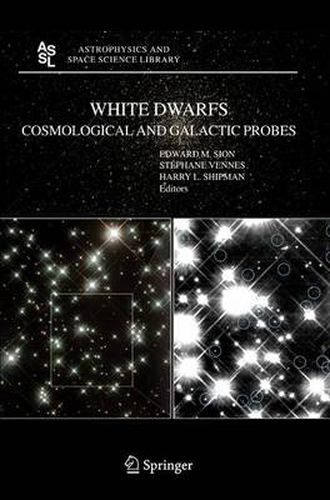Readings Newsletter
Become a Readings Member to make your shopping experience even easier.
Sign in or sign up for free!
You’re not far away from qualifying for FREE standard shipping within Australia
You’ve qualified for FREE standard shipping within Australia
The cart is loading…






This title is printed to order. This book may have been self-published. If so, we cannot guarantee the quality of the content. In the main most books will have gone through the editing process however some may not. We therefore suggest that you be aware of this before ordering this book. If in doubt check either the author or publisher’s details as we are unable to accept any returns unless they are faulty. Please contact us if you have any questions.
In the past few years, general astronomical interest has concentrated on s- eral objects and phenomena where white dwarf stars play a key role. T Type Ia supernovae have been used as evidence to show that, in fact, Einstein did not make his greatest blunder when heallowedfor the possibility of a c- mological constant. Improvements in our knowledge of the Hubble parameter have revived interest in the use of white dwarf stars as a different typeofc- mochronometer to measuretheage of the Galaxy andthus set constraints on the age of the Universe. In roughly the same time period, there have been considerable advances in our understanding of white dwarf stars, both as i- lated stars in the ?eld and as members ofinteracting binary systems. Much of thisadvance has come from theavailabilityof spacecraftobservations from missions like HST T T, IU UE, ROSAT T, EXOSAT T, Chandra, ORFEUS, EUVE, HUT T T, and FUSE. The discovery of thousandsof new white dwarfs from a number oflarge surveys and thepotential of theSloan Digital SkySurvey have added impetus to the ?eld. Studies ofinteracting binaries such as classical novae, supersoft X-ray bi- ries, symbiotic variables, dwarf novae and nova-like objects have revealed the diff ferences between thethermal evolution of singleand close binary systems aswell as heightenedinterest in these systems as progenitors of the cosmol- ically important Type I supernovae. A more speculative question is whether classical novae can beunderstood well enough that theymight provide another kind of standard candle.
$9.00 standard shipping within Australia
FREE standard shipping within Australia for orders over $100.00
Express & International shipping calculated at checkout
This title is printed to order. This book may have been self-published. If so, we cannot guarantee the quality of the content. In the main most books will have gone through the editing process however some may not. We therefore suggest that you be aware of this before ordering this book. If in doubt check either the author or publisher’s details as we are unable to accept any returns unless they are faulty. Please contact us if you have any questions.
In the past few years, general astronomical interest has concentrated on s- eral objects and phenomena where white dwarf stars play a key role. T Type Ia supernovae have been used as evidence to show that, in fact, Einstein did not make his greatest blunder when heallowedfor the possibility of a c- mological constant. Improvements in our knowledge of the Hubble parameter have revived interest in the use of white dwarf stars as a different typeofc- mochronometer to measuretheage of the Galaxy andthus set constraints on the age of the Universe. In roughly the same time period, there have been considerable advances in our understanding of white dwarf stars, both as i- lated stars in the ?eld and as members ofinteracting binary systems. Much of thisadvance has come from theavailabilityof spacecraftobservations from missions like HST T T, IU UE, ROSAT T, EXOSAT T, Chandra, ORFEUS, EUVE, HUT T T, and FUSE. The discovery of thousandsof new white dwarfs from a number oflarge surveys and thepotential of theSloan Digital SkySurvey have added impetus to the ?eld. Studies ofinteracting binaries such as classical novae, supersoft X-ray bi- ries, symbiotic variables, dwarf novae and nova-like objects have revealed the diff ferences between thethermal evolution of singleand close binary systems aswell as heightenedinterest in these systems as progenitors of the cosmol- ically important Type I supernovae. A more speculative question is whether classical novae can beunderstood well enough that theymight provide another kind of standard candle.